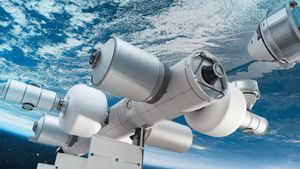JAKARTA – The possibility of life outside Planet Earth has long been a very interesting topic. But to avoid sensationalism and misreporting when humans detect signs of extraterrestrial life, NASA scientists have called for building a framework so that everyone has a clear idea of the true extent of progress.
NASA already has several missions in place looking for signs of life on Mars, one of Jupiter's moons called Europa, and so on. So far, the agency has not found any real signs of extraterrestrial life. But that doesn't mean life beyond planet Earth doesn't exist.
“The universe is a pretty big place. If it's just us, it seems like a terrible waste of space”, Carl Sagan, the US scientist once said. However, scientists have seen conditions in some pockets of space that are theoretically conducive to supporting some forms of life.
Are we alone in the universe?
To understand how one discovery builds on the next, @NASAAstrobio is asking for help to put together a scale that would lead to scientists being confident in saying they found life beyond Earth. https://t.co/d6PY9VVs6p pic.twitter.com/64RmkQItO1
— NASA (@NASA) October 27, 2021
For example, a recent study claims that filtering sunlight through Venus's atmosphere could enable Earth-like phototrophy, meaning certain organisms might be able to harness sunlight and survive the conditions.
Alien life can exist in any form. It can be primordial at the level of microorganisms or even more complex and more advanced than humans. However, the discovery of life can be a drawn-out process, and the result can be anything.
That's why the research team, including NASA scientists, wanted to ensure that reporting on alien biosignature discoveries was done responsibly. To do so, a comprehensive framework must be created so that the report does not hype the findings and end up saying something that is not supported by the available evidence. In simple words, mere biosignature signs should not be reported as tangible evidence of extraterrestrial life.
NASA Alien Life Reporting
SEE ALSO:
To achieve that, the research team proposes to build a scale that gives a better idea of where alien life discovery missions are located. This can be done using something called the "Life Confidence Detection" (CoLD) scale.
Each level of this scale will indicate how close scientists are to detecting alien life. At the lowest scale, scientists will place identification of biosignatures. At a higher scale level, scientists will be able to relate the initial results to strong evidence. Ranking the findings on a fixed scale will ensure that there is no room for misreporting or exaggeration.
Scientists argue that a definite 'yes' or 'no' answer to the search for alien life and related discoveries is not the right approach. Instead, it is very important to study all possible evidence over a long period of time and at multiple stages.
However, creating such a scale to rank 'discovery of alien life' has not yet become a reality. Therefore, the team invites the wider scientific community to engage in dialogue and jointly create standards to determine the level of progress.
A good example of such a scale is TRL (Technology Readiness Level). The TRL scale allows NASA to identify the exact mission stage where Level 1 represents the basic principles observed, Level 2 indicates a technological concept, and a final Level 9 indicates that the flight system has proven its efficiency with successful mission operations.
The English, Chinese, Japanese, Arabic, and French versions are automatically generated by the AI. So there may still be inaccuracies in translating, please always see Indonesian as our main language. (system supported by DigitalSiber.id)


















